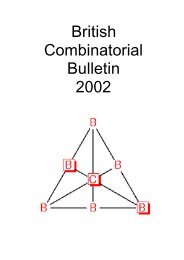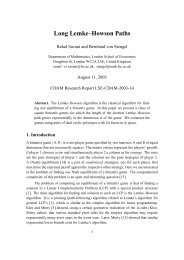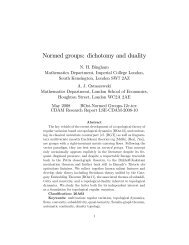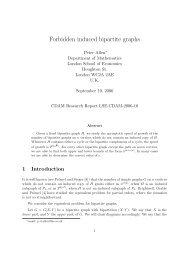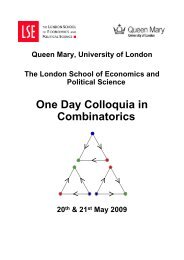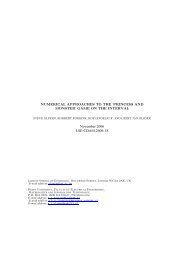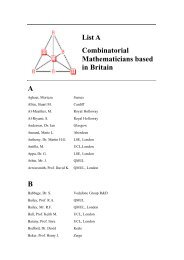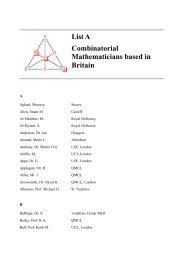Mixing 3-colourings in Bipartite Graphs - Department of Mathematics
Mixing 3-colourings in Bipartite Graphs - Department of Mathematics
Mixing 3-colourings in Bipartite Graphs - Department of Mathematics
You also want an ePaper? Increase the reach of your titles
YUMPU automatically turns print PDFs into web optimized ePapers that Google loves.
<strong>Mix<strong>in</strong>g</strong> 3-<strong>colour<strong>in</strong>gs</strong> <strong>in</strong> <strong>Bipartite</strong> <strong>Graphs</strong><br />
Luis Cereceda 1 , Jan van den Heuvel 1 and Matthew Johnson 2<br />
1 Centre for Discrete and Applicable <strong>Mathematics</strong>, <strong>Department</strong> <strong>of</strong> <strong>Mathematics</strong><br />
London School <strong>of</strong> Economics, Houghton Street, London WC2A 2AE, U.K.<br />
2 <strong>Department</strong> <strong>of</strong> Computer Science, Durham University<br />
Science Laboratories, South Road, Durham DH1 3LE, U.K.<br />
email: {luis,jan} @ maths.lse.ac.uk,<br />
matthew.johnson2 @ durham.ac.uk<br />
CDAM Research Report LSE-CDAM-2006-08 — July 2006<br />
Abstract<br />
For a 3-colourable graph G, the 3-colour graph <strong>of</strong> G, denoted C 3 (G), is the graph with node<br />
set the proper vertex 3-<strong>colour<strong>in</strong>gs</strong> <strong>of</strong> G, and two nodes adjacent whenever the correspond<strong>in</strong>g<br />
<strong>colour<strong>in</strong>gs</strong> differ on precisely one vertex <strong>of</strong> G. We consider the follow<strong>in</strong>g question :<br />
given G, how easily can we decide whether or not C 3 (G) is connected? We show that the<br />
3-colour graph <strong>of</strong> a 3-chromatic graph is never connected, and characterise the bipartite<br />
graphs for which C 3 (G) is connected. We also show that the problem <strong>of</strong> decid<strong>in</strong>g the connectedness<br />
<strong>of</strong> the 3-colour graph <strong>of</strong> a bipartite graph is <strong>in</strong> the complexity class co-NP,<br />
and that restricted to planar bipartite graphs, the question is answerable <strong>in</strong> polynomial<br />
time.<br />
1 Introduction<br />
Throughout this paper a graph G = (V, E) is simple, loopless and f<strong>in</strong>ite. Most <strong>of</strong> our term<strong>in</strong>ology<br />
and notation is standard and can be found <strong>in</strong> any textbook on graph theory such<br />
as, for example, [3]. We always regard a k-colour<strong>in</strong>g <strong>of</strong> a graph G as proper; that is, as a<br />
function α : V → {1, 2, . . . , k} such that α(u) ≠ α(v) for any uv ∈ E. For a positive <strong>in</strong>teger k<br />
and a graph G, we def<strong>in</strong>e the k-colour graph <strong>of</strong> G, denoted C k (G), as the graph that has the<br />
k-<strong>colour<strong>in</strong>gs</strong> <strong>of</strong> G as its node set, with two k-<strong>colour<strong>in</strong>gs</strong> jo<strong>in</strong>ed by an edge <strong>in</strong> C k (G) if they<br />
differ <strong>in</strong> colour on just one vertex <strong>of</strong> G.<br />
Cont<strong>in</strong>u<strong>in</strong>g a theme begun <strong>in</strong> an earlier paper [2], we <strong>in</strong>vestigate the connectedness <strong>of</strong> C k (G)<br />
for a given G, this time concentrat<strong>in</strong>g on the case k = 3. The connectedness <strong>of</strong> the k-colour<br />
graph is an issue <strong>of</strong> <strong>in</strong>terest when try<strong>in</strong>g to obta<strong>in</strong> efficient algorithms for almost uniform<br />
sampl<strong>in</strong>g <strong>of</strong> k-<strong>colour<strong>in</strong>gs</strong> <strong>of</strong> a given graph. In particular, C k (G) needs to be connected for the<br />
1
s<strong>in</strong>gle-site Glauber dynamics <strong>of</strong> G ( a Markov cha<strong>in</strong> def<strong>in</strong>ed on the k-colour graph <strong>of</strong> G ) to<br />
be rapidly mix<strong>in</strong>g. For further details, see, for example, [5, 6] and references there<strong>in</strong>.<br />
We outl<strong>in</strong>e some <strong>of</strong> our term<strong>in</strong>ology and notation. We use α, β, . . . to denote specific<br />
<strong>colour<strong>in</strong>gs</strong>. We say that G is k-mix<strong>in</strong>g if C k (G) is connected, and, hav<strong>in</strong>g def<strong>in</strong>ed the <strong>colour<strong>in</strong>gs</strong><br />
as nodes <strong>of</strong> C k (G), the mean<strong>in</strong>g <strong>of</strong>, for example, the path between two <strong>colour<strong>in</strong>gs</strong> should be<br />
clear. Observe that a graph G is k-mix<strong>in</strong>g if and only if every connected component <strong>of</strong> G<br />
is k-mix<strong>in</strong>g, so we will usually take our “argument graph” G to be connected. We assume<br />
throughout that k ≥ χ(G) ≥ 2, where χ(G) is the chromatic number <strong>of</strong> G. We use the term<br />
frozen for a k-colour<strong>in</strong>g <strong>of</strong> a graph G that forms an isolated node <strong>in</strong> the k-colour graph. Note<br />
that the existence <strong>of</strong> a frozen k-colour<strong>in</strong>g <strong>of</strong> a graph immediately implies that the graph is<br />
not k-mix<strong>in</strong>g.<br />
If G has a k-colour<strong>in</strong>g α, then we say that we can recolour G with β if αβ is an edge<br />
<strong>of</strong> C k (G). If v is the unique vertex on which α and β differ, then we also say that we can<br />
recolour v.<br />
We denote the cycle on n vertices by C n , and will <strong>of</strong>ten describe a colour<strong>in</strong>g <strong>of</strong> C n by just<br />
list<strong>in</strong>g the colours as they appear on consecutive vertices.<br />
The rema<strong>in</strong>der <strong>of</strong> this paper is set out as follows. In the follow<strong>in</strong>g section we <strong>in</strong>troduce<br />
some <strong>of</strong> our tools and methods, revisit<strong>in</strong>g the pro<strong>of</strong> ( given <strong>in</strong> [2] ) that 3-chromatic graphs are<br />
not 3-mix<strong>in</strong>g. Section 3 gives two equivalent characterisations <strong>of</strong> 3-mix<strong>in</strong>g bipartite graphs.<br />
In Section 4 we consider the problem <strong>of</strong> decid<strong>in</strong>g whether a given bipartite graph is 3-mix<strong>in</strong>g :<br />
we show that this problem is <strong>in</strong> the complexity class co-NP and describe an algorithm that<br />
answers the question for bipartite planar graphs <strong>in</strong> polynomial time.<br />
2 Prelim<strong>in</strong>aries<br />
In [2] it was shown that if G has chromatic number k for k = 2, 3, then G is not k-mix<strong>in</strong>g,<br />
but that, on the other hand, for k ≥ 4, there are k-chromatic graphs that are k-mix<strong>in</strong>g and<br />
k-chromatic graphs that are not k-mix<strong>in</strong>g. For completeness, and s<strong>in</strong>ce several <strong>of</strong> the ideas<br />
are used <strong>in</strong> later parts <strong>of</strong> this paper, we <strong>in</strong>clude a pro<strong>of</strong> <strong>of</strong> the fact that 3-chromatic graphs<br />
are not 3-mix<strong>in</strong>g. Let us first give some def<strong>in</strong>itions.<br />
Given a 3-colour<strong>in</strong>g α, the weight <strong>of</strong> an edge e = uv oriented from u to v is<br />
w( −→ uv, α) =<br />
{<br />
+1, if α(u)α(v) ∈ {12, 23, 31};<br />
−1, if α(u)α(v) ∈ {21, 32, 13}.<br />
To orient a cycle means to orient each edge on the cycle so that a directed cycle is obta<strong>in</strong>ed.<br />
If C is a cycle, then by −→ C we denote the cycle with one <strong>of</strong> the two possible orientations. The<br />
weight W ( −→ C , α) <strong>of</strong> an oriented cycle −→ C is the sum <strong>of</strong> the weights <strong>of</strong> its oriented edges.<br />
Lemma 1 Let α and β be 3-<strong>colour<strong>in</strong>gs</strong> <strong>of</strong> a graph G that conta<strong>in</strong>s a cycle C. Then if α<br />
and β are <strong>in</strong> the same component <strong>of</strong> C 3 (G), we must have W ( −→ C , α) = W ( −→ C , β).<br />
Pro<strong>of</strong> : Let α and α ′ be 3-<strong>colour<strong>in</strong>gs</strong> <strong>of</strong> G that are adjacent <strong>in</strong> C 3 (G), and suppose the two<br />
3-<strong>colour<strong>in</strong>gs</strong> differ on vertex v. If v is not on C, then we certa<strong>in</strong>ly have W ( −→ C , α) = W ( −→ C , α ′ ).<br />
(1)<br />
2
If v is a vertex <strong>of</strong> C, then its two neighbours on C must have the same colour <strong>in</strong> α, else we<br />
wouldn’t be able to recolour v. If we denote the <strong>in</strong>-neighbour <strong>of</strong> v on −→ C by v i and its outneighbour<br />
by v o , then w( −→ v i v, α) and w( −→ vv o , α) have opposite sign, and w( −→ v i v, α)+w( −→ vv o , α) =<br />
0.<br />
Recolour<strong>in</strong>g vertex v will change the signs <strong>of</strong> the weights <strong>of</strong> the oriented edges −→ v i v and −→ vv o ,<br />
but they will rema<strong>in</strong> opposite. Therefore w( −→ v i v, α ′ ) + w( −→ vv o , α ′ ) = 0, and W ( −→ C , α) =<br />
W ( −→ C , α ′ ). From this we immediately obta<strong>in</strong> that the weight <strong>of</strong> an oriented cycle is constant<br />
on all 3-<strong>colour<strong>in</strong>gs</strong> <strong>in</strong> the same component <strong>of</strong> C 3 (G).<br />
✷<br />
Note that the converse <strong>of</strong> Lemma 1 is not true. For <strong>in</strong>stance the 3-cycle has six 3-<strong>colour<strong>in</strong>gs</strong>.<br />
Of these, 1-2-3, 2-3-1 and 3-1-2 give the same weight <strong>of</strong> the oriented 3-cycle, but they are not<br />
connected — <strong>in</strong> fact, they are all frozen.<br />
Lemma 2 Let α be a 3-colour<strong>in</strong>g <strong>of</strong> a graph G that conta<strong>in</strong>s a cycle C. If W ( −→ C , α) ≠ 0,<br />
then C 3 (G) is not connected.<br />
Pro<strong>of</strong> : Let β be the 3-colour<strong>in</strong>g <strong>of</strong> G obta<strong>in</strong>ed by sett<strong>in</strong>g for each vertex v <strong>of</strong> G :<br />
⎧<br />
⎪⎨ 1, if α(v) = 2;<br />
β(v) = 2, if α(v) = 1;<br />
⎪⎩<br />
3, if α(v) = 3.<br />
It is easy to check that for each edge e <strong>in</strong> C, w(⃗e, α) = −w(⃗e, β), which gives W ( −→ C , α) =<br />
−W ( −→ C , β). S<strong>in</strong>ce W ( −→ C , α) ≠ 0, we must have W ( −→ C , α) ≠ W ( −→ C , β), and so, by Lemma 1, α<br />
and β belong to different components <strong>of</strong> C 3 (G).<br />
✷<br />
Theorem 3 Let G be a 3-chromatic graph. Then G is not 3-mix<strong>in</strong>g.<br />
Pro<strong>of</strong> : As G has chromatic number 3, it conta<strong>in</strong>s a cycle C <strong>of</strong> odd length. Let α be a<br />
3-colour<strong>in</strong>g <strong>of</strong> G, and note that as the weight <strong>of</strong> each edge <strong>in</strong> −→ C is +1 or −1, W ( −→ C , α) ≠ 0.<br />
We are done by Lemma 2.<br />
✷<br />
3 Characteris<strong>in</strong>g 3-mix<strong>in</strong>g bipartite graphs<br />
We have seen that 3-chromatic graphs are not 3-mix<strong>in</strong>g. What can be said for bipartite<br />
graphs? Examples <strong>of</strong> 3-mix<strong>in</strong>g bipartite graphs <strong>in</strong>clude trees and C 4 , the cycle on 4 vertices.<br />
On the other hand, all cycles except C 4 are not 3-mix<strong>in</strong>g — see [2] for details. In Theorem 4<br />
we dist<strong>in</strong>guish between 3-mix<strong>in</strong>g and non-3-mix<strong>in</strong>g bipartite graphs <strong>in</strong> terms <strong>of</strong> their structure<br />
and the possible 3-<strong>colour<strong>in</strong>gs</strong> they may have.<br />
If v and w are vertices <strong>of</strong> a bipartite graph G at distance two, then a p<strong>in</strong>ch on v and w is<br />
the identification <strong>of</strong> v and w ( together with the removal <strong>of</strong> any double edges produced ). We<br />
say that G is p<strong>in</strong>chable to a graph H if there exists a sequence <strong>of</strong> p<strong>in</strong>ches that transforms G<br />
<strong>in</strong>to H.<br />
3
Theorem 4 Let G be a connected bipartite graph. The follow<strong>in</strong>g are equivalent :<br />
(i) The graph G is not 3-mix<strong>in</strong>g.<br />
(ii) There exists a cycle C <strong>in</strong> G and a 3-colour<strong>in</strong>g α <strong>of</strong> G with W ( −→ C , α) ≠ 0.<br />
(iii) The graph G is p<strong>in</strong>chable to the 6-cycle C 6 .<br />
To prove Theorem 4, we need some def<strong>in</strong>itions and technical lemmas. For the rest <strong>of</strong> this<br />
section, let G = (V, E) denote a connected bipartite graph with vertex bipartition X, Y .<br />
Given a 3-colour<strong>in</strong>g α <strong>of</strong> G, we def<strong>in</strong>e a height function for α with base X as a function<br />
h : V → Z satisfy<strong>in</strong>g the follow<strong>in</strong>g conditions. ( See [1, 4] for other, similar height functions. )<br />
H1 For all v ∈ X, h(v) ≡ 0 (mod 2); for all v ∈ Y , h(v) ≡ 1 (mod 2).<br />
H2 For all uv ∈ E, h(v) − h(u) = w( −→ uv, α) ( ∈ {−1, +1} ).<br />
H3 For all v ∈ V , h(v) ≡ α(v) (mod 3).<br />
If h : V → Z satisfies conditions H2, H3 and also<br />
H1 ′ For all v ∈ X, h(v) ≡ 1 (mod 2); while for v ∈ Y , h(v) ≡ 0 (mod 2).<br />
then h is said to be a height function for α with base Y .<br />
Observe that for a particular colour<strong>in</strong>g <strong>of</strong> a given G, a height function might not exist.<br />
An example <strong>of</strong> this is the 6-cycle C 6 coloured 1-2-3-1-2-3.<br />
Conversely, however, a function h : V → Z satisfy<strong>in</strong>g conditions H1 and H2 <strong>in</strong>duces a<br />
3-colour<strong>in</strong>g <strong>of</strong> G : the unique α : V → {1, 2, 3} satisfy<strong>in</strong>g condition H3, and h is <strong>in</strong> fact a<br />
height function for this α. Observe also that if h is a height function for α with base X,<br />
then so are h + 6 and h − 6; while h + 3 and h − 3 are height functions for α with base Y .<br />
Because we will be concerned solely with the question <strong>of</strong> existence <strong>of</strong> height functions, we<br />
assume henceforth that for a given G, all height functions have base X. Thus we let H X (G)<br />
be the set <strong>of</strong> height functions with base X correspond<strong>in</strong>g to some 3-colour<strong>in</strong>g <strong>of</strong> G, and def<strong>in</strong>e<br />
a metric m on H X (G) by sett<strong>in</strong>g<br />
m(h 1 , h 2 ) = ∑ v∈V<br />
|h 1 (v) − h 2 (v)|,<br />
for h 1 , h 2 ∈ H X (G). Note that condition H1 above implies that m(h 1 , h 2 ) is always even.<br />
For a given height function h, h(v) is said to be a local maximum ( respectively, local<br />
m<strong>in</strong>imum ) if h(v) is larger than ( respectively, smaller than ) h(u) for all neighbours u <strong>of</strong> v.<br />
Follow<strong>in</strong>g [4], we def<strong>in</strong>e the follow<strong>in</strong>g height transformations on h.<br />
– An <strong>in</strong>creas<strong>in</strong>g height transformation takes a { local m<strong>in</strong>imum h(v) <strong>of</strong> h and transforms h<br />
<strong>in</strong>to the height function h ′ given by h ′ h(x) + 2, if x = v;<br />
(x) =<br />
h(x), if x ≠ v.<br />
– A decreas<strong>in</strong>g height transformation takes a local { maximum h(v) <strong>of</strong> h and transforms h<br />
<strong>in</strong>to the height function h ′ given by h ′ h(x) − 2, if x = v;<br />
(x) =<br />
h(x), if x ≠ v.<br />
Notice that these height transformations give rise to transformations between the correspond<strong>in</strong>g<br />
<strong>colour<strong>in</strong>gs</strong>. Specifically, if we let α ′ be the 3-colour<strong>in</strong>g correspond<strong>in</strong>g to h ′ , an<br />
4
<strong>in</strong>creas<strong>in</strong>g transformation yields α ′ (v) = α(v) − 1, while a decreas<strong>in</strong>g transformation yields<br />
α ′ (v) = α(v) + 1, where addition is modulo 3.<br />
The follow<strong>in</strong>g lemma, a simple extension <strong>of</strong> the range <strong>of</strong> applicability <strong>of</strong> a similar lemma<br />
appear<strong>in</strong>g <strong>in</strong> [4], shows that <strong>colour<strong>in</strong>gs</strong> with height functions are connected <strong>in</strong> C 3 (G).<br />
Lemma 5 ([4]) Let α, β be two 3-<strong>colour<strong>in</strong>gs</strong> <strong>of</strong> G with correspond<strong>in</strong>g height functions h α , h β .<br />
Then there is a path between α and β <strong>in</strong> C 3 (G).<br />
Pro<strong>of</strong> : We use <strong>in</strong>duction on m(h α , h β ). The lemma is trivially true when m(h α , h β ) = 0,<br />
s<strong>in</strong>ce <strong>in</strong> this case α and β are identical.<br />
Suppose therefore that m(h α , h β ) > 0. We show that there is a height transformation<br />
transform<strong>in</strong>g h α <strong>in</strong>to some height function h with m(h, h β ) = m(h α , h β ) − 2, from which the<br />
lemma follows.<br />
Without loss <strong>of</strong> generality, let us assume that there is some vertex v ∈ V with h α (v) ><br />
h β (v), and choose v with h α (v) as large as possible. We show that such a v must be a<br />
local maximum <strong>of</strong> h α . Let u be any neighbour <strong>of</strong> v. If h α (u) > h β (u), then it follows that<br />
h α (v) > h α (u), s<strong>in</strong>ce v was chosen with h α (v) maximum, and |h α (v) − h α (u)| = 1. If, on the<br />
other hand, h α (u) ≤ h β (u), we have h α (v) ≥ h β (v) + 1 ≥ h β (u) ≥ h α (u), which <strong>in</strong> fact means<br />
h α (v) > h α (u).<br />
Thus h α (v) > h α (u) for all neighbours u <strong>of</strong> v, and we can apply a decreas<strong>in</strong>g height<br />
transformation to h α at v to obta<strong>in</strong> h. Clearly m(h, h β ) = m(h α , h β ) − 2.<br />
✷<br />
The next lemma tells us that for a given 3-colour<strong>in</strong>g, non-zero weight cycles are, <strong>in</strong> some sense,<br />
the obstruct<strong>in</strong>g configurations forbidd<strong>in</strong>g the existence <strong>of</strong> a correspond<strong>in</strong>g height function.<br />
Lemma 6 Let α be a 3-colour<strong>in</strong>g <strong>of</strong> G with no correspond<strong>in</strong>g height function. Then G conta<strong>in</strong>s<br />
a cycle C for which W ( −→ C , α) ≠ 0.<br />
Pro<strong>of</strong> : For a path P <strong>in</strong> G, let −→ P denote one <strong>of</strong> the two possible directed paths obta<strong>in</strong>able<br />
from P , and let<br />
W ( −→ P , α) =<br />
∑<br />
w(⃗e, α),<br />
⃗e∈E( −→ P )<br />
where w(⃗e, α) takes values as def<strong>in</strong>ed <strong>in</strong> (1).<br />
Notice that if a colour<strong>in</strong>g does have a height function, it is possible to construct one by<br />
fix<strong>in</strong>g a vertex x ∈ X, giv<strong>in</strong>g x an appropriate height ( satisfy<strong>in</strong>g properties H1–H3 ) and then<br />
assign<strong>in</strong>g heights to all vertices <strong>in</strong> V by follow<strong>in</strong>g a breadth-first order<strong>in</strong>g from x.<br />
Whenever we attempt to construct a height function h for α <strong>in</strong> such a fashion, we must<br />
come to a stage <strong>in</strong> the order<strong>in</strong>g where we attempt to give some vertex v a height h(v) and<br />
f<strong>in</strong>d ourselves unable to because v has a neighbour u with a previously assigned height h(u)<br />
and |h(u) − h(v)| > 1. Lett<strong>in</strong>g P be a path between u and v formed by vertices that have<br />
been assigned a height, and choos<strong>in</strong>g the appropriate orientation <strong>of</strong> P , we have w( −→ P , α) =<br />
|h(u)−h(v)|. The lemma now follows by lett<strong>in</strong>g C be the cycle formed by P and the edge uv. ✷<br />
The follow<strong>in</strong>g lemma is obvious.<br />
5
Lemma 7 Let u and v be vertices on a cycle C <strong>in</strong> a graph G, and suppose there is a path P<br />
between u and v <strong>in</strong> G <strong>in</strong>ternally disjo<strong>in</strong>t from C. Let α be a 3-colour<strong>in</strong>g <strong>of</strong> G. Let C ′ and C ′′<br />
be the two cycles formed from P and edges <strong>of</strong> C, and let −→ C ′ , −→ C ′′ be the orientations <strong>of</strong> C ′ , C ′′<br />
<strong>in</strong>duced by an orientation −→ C <strong>of</strong> C ( so the edges <strong>of</strong> P have opposite orientations <strong>in</strong> −→ C ′ and −→ C ′′ ).<br />
Then W ( −→ C , α) = W ( −→ C ′ , α) + W ( −→ C ′′ , α).<br />
Note this tells us that W ( −→ C , α) ≠ 0 implies W ( −→ C ′ , α) ≠ 0 or W ( −→ C ′′ , α) ≠ 0.<br />
Pro<strong>of</strong> <strong>of</strong> Theorem 4 : Let G be a connected bipartite graph.<br />
(i) =⇒ (ii). Suppose C 3 (G) is not connected. Take two 3-<strong>colour<strong>in</strong>gs</strong> <strong>of</strong> G, α and β, <strong>in</strong><br />
different components <strong>of</strong> C 3 (G). By Lemma 5 we know at least one <strong>of</strong> them, say α, has no<br />
correspond<strong>in</strong>g height function, and, by Lemma 6, there is a cycle C <strong>in</strong> G with W ( −→ C , α) ≠ 0.<br />
(ii) =⇒ (iii). Let G conta<strong>in</strong> a cycle C with W ( −→ C , α) ≠ 0 for some 3-colour<strong>in</strong>g α <strong>of</strong> G.<br />
Because W ( −→ C 4 , β) = 0 for any 3-colour<strong>in</strong>g β <strong>of</strong> C 4 , it follows that C = C n for some even<br />
n ≥ 6. If G = C, then a sequence <strong>of</strong> arbitrary p<strong>in</strong>ches will yield C 6 . If G is C plus some<br />
chords, then Lemma 7 tells us that there is a smaller cycle C ′ with W ( −→ C ′ , α) ≠ 0. Thus if<br />
G ≠ C, we can assume that V (G) ≠ V (C), and we describe how to p<strong>in</strong>ch a pair <strong>of</strong> vertices so<br />
that (ii) rema<strong>in</strong>s satisfied ( for a specified cycle with G replaced by the graph created by the<br />
p<strong>in</strong>ch and α replaced by its restriction to that graph; also denoted α ); by repetition, we can<br />
obta<strong>in</strong> a graph that is a cycle and, by the previous observations, the implication is proved.<br />
Note that we shall choose vertices coloured alike to p<strong>in</strong>ch so that the restriction <strong>of</strong> α to<br />
the graph obta<strong>in</strong>ed is well-def<strong>in</strong>ed and proper. If C has three consecutive vertices u, v, w<br />
with α(u) = α(w), p<strong>in</strong>ch<strong>in</strong>g u and w yields a graph conta<strong>in</strong><strong>in</strong>g a cycle C ′ = C n−2 with<br />
W ( −→ C ′ , α) = W ( −→ C , α). Otherwise C is coloured 1-2-3-· · · -1-2-3. We can choose u, v, w to be<br />
three consecutive vertices <strong>of</strong> C, such that there is a vertex x /∈ V (C) adjacent to v. Suppose,<br />
without loss <strong>of</strong> generality, that α(x) = α(u), and p<strong>in</strong>ch x and u to obta<strong>in</strong> a graph <strong>in</strong> which<br />
W ( −→ C , α) is unchanged.<br />
(iii) =⇒ (i). Suppose G is p<strong>in</strong>chable to C 6 . Take two 3-<strong>colour<strong>in</strong>gs</strong> <strong>of</strong> C 6 not connected<br />
by a path <strong>in</strong> C 3 (C 6 ) — 1-2-3-1-2-3 and 1-2-1-2-1-2, for example. Consider<strong>in</strong>g the appropriate<br />
orientation <strong>of</strong> C 6 , note that the first colour<strong>in</strong>g has weight 6 and the second has weight 0. We<br />
construct two 3-<strong>colour<strong>in</strong>gs</strong> <strong>of</strong> G not connected by a path <strong>in</strong> C 3 (G) as follows. Consider the<br />
reverse sequence <strong>of</strong> p<strong>in</strong>ches that gives G from C 6 . Follow<strong>in</strong>g this sequence, for each colour<strong>in</strong>g<br />
<strong>of</strong> C 6 , give every pair <strong>of</strong> new vertices <strong>in</strong>troduced by an “unp<strong>in</strong>ch<strong>in</strong>g” the same colour as<br />
the vertex from which they orig<strong>in</strong>ated. In this manner we obta<strong>in</strong> two 3-<strong>colour<strong>in</strong>gs</strong> <strong>of</strong> G, α<br />
and β, say. Observe that every unp<strong>in</strong>ch<strong>in</strong>g ma<strong>in</strong>ta<strong>in</strong>s a cycle <strong>in</strong> G which has weight 6 with<br />
respect to the colour<strong>in</strong>g <strong>in</strong>duced by the first colour<strong>in</strong>g <strong>of</strong> C 6 and weight 0 with respect to the<br />
second <strong>in</strong>duced colour<strong>in</strong>g. This means G will conta<strong>in</strong> a cycle C for which W ( −→ C , α) = 6 and<br />
W ( −→ C , β) = 0, show<strong>in</strong>g that α and β cannot possibly be <strong>in</strong> the same connected component<br />
<strong>of</strong> C 3 (G).<br />
This completes the pro<strong>of</strong> <strong>of</strong> the theorem.<br />
✷<br />
6
4 Recognis<strong>in</strong>g 3-mix<strong>in</strong>g bipartite graphs<br />
Let us now turn our attention to the computational complexity <strong>of</strong> decid<strong>in</strong>g whether or not a<br />
3-colourable graph G is 3-mix<strong>in</strong>g. From Theorem 3 we know that we can restrict our attention<br />
to bipartite graphs, so we state the decision problem formally as follows.<br />
3-<strong>Mix<strong>in</strong>g</strong><br />
Instance : <strong>Bipartite</strong> graph G.<br />
Question : Is G 3-mix<strong>in</strong>g?<br />
Observ<strong>in</strong>g that Theorem 4 gives us two polynomial-time verifiable certificates for when G<br />
is not 3-mix<strong>in</strong>g, we immediately obta<strong>in</strong> that 3-<strong>Mix<strong>in</strong>g</strong> is <strong>in</strong> the complexity class co-NP.<br />
Whether 3-<strong>Mix<strong>in</strong>g</strong> is also <strong>in</strong> the complexity class NP — which would then suggest that it<br />
is likely to be <strong>in</strong> P — or <strong>in</strong>deed is co-NP-complete, rema<strong>in</strong>s an open question.<br />
In the rest <strong>of</strong> this section, we prove the follow<strong>in</strong>g.<br />
Theorem 8 Restricted to planar bipartite graphs, the decision problem 3-<strong>Mix<strong>in</strong>g</strong> is <strong>in</strong> the<br />
complexity class P.<br />
Henceforth, let G denote a bipartite planar graph.<br />
technical results.<br />
To prove the theorem we need some<br />
Lemma 9 Let P be a shortest path between dist<strong>in</strong>ct vertices u and v <strong>in</strong> a bipartite graph H.<br />
Then H is p<strong>in</strong>chable to P .<br />
Pro<strong>of</strong> : Let P have vertices u = v 0 , v 1 , . . . , v k−1 , v k = v, and let T be a breadth-first spann<strong>in</strong>g<br />
tree <strong>of</strong> H rooted at u that conta<strong>in</strong>s P ( we can choose T so that it conta<strong>in</strong>s P s<strong>in</strong>ce P is a<br />
shortest path ). Now, work<strong>in</strong>g <strong>in</strong> T , p<strong>in</strong>ch all vertices at distance one from u to v 1 . Next<br />
p<strong>in</strong>ch all vertices at distance two from u to v 2 . Cont<strong>in</strong>ue until all vertices at distance k from u<br />
are p<strong>in</strong>ched to v k = v. If necessary, arbitrary p<strong>in</strong>ches on the vertices at distance at least k + 1<br />
from u will yield P .<br />
✷<br />
Lemma 10 Let H be a bipartite graph.<br />
(i) Let u and v be two vertices <strong>in</strong> H properly pre-coloured with colours from 1, 2, 3. Then<br />
this colour<strong>in</strong>g can be extended to a proper 3-colour<strong>in</strong>g <strong>of</strong> H.<br />
(ii) Let u, v and w be three vertices <strong>in</strong> H with uv, vw ∈ E(H). Suppose u, v, w are properly<br />
pre-coloured with colours from 1, 2, 3. Then this colour<strong>in</strong>g can be extended to a proper<br />
3-colour<strong>in</strong>g <strong>of</strong> H.<br />
(iii) Suppose the vertices <strong>of</strong> a 4-cycle <strong>in</strong> H are properly 3-coloured. Then this 3-colour<strong>in</strong>g<br />
can be extended to a proper 3-colour<strong>in</strong>g <strong>of</strong> H.<br />
Pro<strong>of</strong> : (i) is trivial.<br />
(ii) Without loss <strong>of</strong> generality we can assume that the colour<strong>in</strong>g <strong>of</strong> u, v, w is 1-2-1 or 1-2-3.<br />
In the first <strong>in</strong>stance, s<strong>in</strong>ce H is bipartite, we can extend the colour<strong>in</strong>g <strong>of</strong> u, v, w to a colour<strong>in</strong>g<br />
7
<strong>of</strong> H us<strong>in</strong>g colours 1 and 2 only. For the second case, we can use the same 1,2-colour<strong>in</strong>g,<br />
except leav<strong>in</strong>g w with colour 3.<br />
(iii) S<strong>in</strong>ce any 3-colour<strong>in</strong>g <strong>of</strong> a C 4 has two vertices with the same colour, without loss <strong>of</strong><br />
generality we can assume the 4 vertices are coloured 1-2-1-2 or 1-2-1-3. Colour<strong>in</strong>gs similar to<br />
those used <strong>in</strong> (ii) above will immediately lead to the appropriate 3-<strong>colour<strong>in</strong>gs</strong> <strong>of</strong> H. ✷<br />
The sequence <strong>of</strong> claims that follows outl<strong>in</strong>es an algorithm that, given G as <strong>in</strong>put, determ<strong>in</strong>es<br />
<strong>in</strong> polynomial time whether or not G is 3-mix<strong>in</strong>g.<br />
The first claim is a simple observation.<br />
Claim 1 If G is not connected, then G is 3-mix<strong>in</strong>g if and only if every component <strong>of</strong> G is<br />
3-mix<strong>in</strong>g.<br />
We next show how we can reduce the case to 2-connected graphs.<br />
Claim 2 Suppose G has a cut-vertex v. Let H 1 be a component <strong>of</strong> G − v. Denote by G 1 the<br />
subgraph <strong>of</strong> G <strong>in</strong>duced by V (H 1 ) ∪ {v}, and let G 2 be the subgraph <strong>in</strong>duced by V (G) \ V (H 1 ).<br />
Then G is 3-mix<strong>in</strong>g if and only if both G 1 and G 2 are 3-mix<strong>in</strong>g.<br />
Pro<strong>of</strong> : If G is 3-mix<strong>in</strong>g, then clearly so are G 1 and G 2 . Conversely, if G is not 3-mix<strong>in</strong>g, we<br />
know by Theorem 4 that there must exist a 3-colour<strong>in</strong>g α <strong>of</strong> G and a cycle C <strong>in</strong> G such that<br />
W ( −→ C , α) ≠ 0. But because C must lie completely <strong>in</strong> G 1 or G 2 , we have that G 1 or G 2 is not<br />
3-mix<strong>in</strong>g.<br />
✷<br />
Now we can assume that G is 2-connected.<br />
actually assume G to be 3-connected.<br />
In the next claim we will show that we can<br />
Claim 3 Suppose G has a 2-vertex-cut {u, v}. Let H 1 be a component <strong>of</strong> G − {u, v}. Denote<br />
by G 1 the subgraph <strong>of</strong> G <strong>in</strong>duced by V (H 1 ) ∪ {u, v}, and let G 2 be the subgraph <strong>in</strong>duced by<br />
V (G) \ V (H 1 ). For i = 1, 2, let l i be the distance between u and v <strong>in</strong> G i .<br />
Then only the follow<strong>in</strong>g cases can occur :<br />
(i)<br />
We have l 1 = l 2 = 1. Then G is 3-mix<strong>in</strong>g if and only if both G 1 and G 2 are 3-mix<strong>in</strong>g.<br />
(ii) We have l 1 = l 2 = 2. ( So for i = 1, 2, there is a vertex w i ∈ V (G i ) so that uw i , vw i ∈<br />
E(G i ). ) Let G ∗ 1 be the subgraph <strong>of</strong> G <strong>in</strong>duced by V (G 1)∪{w 2 } and let G ∗ 2 be the subgraph<br />
<strong>in</strong>duced by V (G 2 )∪{w 1 }. Then G is 3-mix<strong>in</strong>g if and only if both G ∗ 1 and G∗ 2 are 3-mix<strong>in</strong>g.<br />
(iii) We have l 1 + l 2 ≥ 6. Then G is not 3-mix<strong>in</strong>g.<br />
Pro<strong>of</strong> : Because G is bipartite, l 1 and l 2 must have the same parity. If l 1 = 1 or l 2 = 1,<br />
then there is an edge uv <strong>in</strong> G, and this same edge must appear <strong>in</strong> both G 1 and G 2 . This<br />
guarantees that both l 1 = l 2 = 1, and shows that we always have one <strong>of</strong> the three cases.<br />
(i) In this case we have an edge uv <strong>in</strong> all <strong>of</strong> G, G 1 , G 2 . If one <strong>of</strong> G 1 and G 2 is not 3-mix<strong>in</strong>g,<br />
say G 1 , we must have a 3-colour<strong>in</strong>g α <strong>of</strong> G 1 and a cycle C <strong>in</strong> G 1 for which W ( −→ C , α) ≠ 0.<br />
By Lemma 10 (i) we can easily extend α to the whole <strong>of</strong> G, show<strong>in</strong>g that G is not 3-mix<strong>in</strong>g.<br />
8
On the other hand, if G is not 3-mix<strong>in</strong>g, we know we must have a 3-colour<strong>in</strong>g β <strong>of</strong> G and a<br />
cycle D <strong>in</strong> G for which W ( −→ D, β) ≠ 0. If D is conta<strong>in</strong>ed entirely <strong>in</strong> one <strong>of</strong> G 1 or G 2 , we are<br />
done. If not, D must pass through u and v. For i = 1, 2, consider the cycle D i formed from<br />
the part <strong>of</strong> D that is <strong>in</strong> G i together with the edge uv. From Lemma 7 it follows that one<br />
<strong>of</strong> D 1 and D 2 has non-zero weight under β, show<strong>in</strong>g that G 1 or G 2 is not 3-mix<strong>in</strong>g.<br />
(ii) If one <strong>of</strong> G ∗ 1 and G∗ 2 is not 3-mix<strong>in</strong>g, we can use a similar argument as <strong>in</strong> (i) ( now<br />
us<strong>in</strong>g Lemma 10 (ii) ) to conclude that G is not 3-mix<strong>in</strong>g. For the converse we assume G is<br />
not 3-mix<strong>in</strong>g. So there is a 3-colour<strong>in</strong>g α <strong>of</strong> G and a cycle C <strong>in</strong> G for which W ( −→ C , α) ≠ 0.<br />
If C is conta<strong>in</strong>ed entirely <strong>in</strong> one <strong>of</strong> G 1 or G 2 , we are done. If not, C must pass through u<br />
and v. If C does not conta<strong>in</strong> w 1 , then for i = 1, 2, consider the cycle C i formed from the part<br />
<strong>of</strong> C that is <strong>in</strong> G ∗ i together with the path uw 1v. From Lemma 7 it follows that one <strong>of</strong> C 1 , C 2<br />
has non-zero weight under α, show<strong>in</strong>g that G 1 or G 2 is not 3-mix<strong>in</strong>g. If w 1 is conta<strong>in</strong>ed <strong>in</strong> C,<br />
then we can use the same argument but now us<strong>in</strong>g the edge uw 1 or vw 1 as the path ( at least<br />
one <strong>of</strong> these edges is not on C s<strong>in</strong>ce C is not conta<strong>in</strong>ed entirely <strong>in</strong> G 2 ).<br />
(iii) For i = 1, 2, let P i be a shortest path between u and v <strong>in</strong> G i , so P i has length l i .<br />
Then, us<strong>in</strong>g Lemma 9, we can see that G is p<strong>in</strong>chable to C l1 +l 2<br />
— just follow, <strong>in</strong> G, the<br />
sequence <strong>of</strong> p<strong>in</strong>ches that transforms G 1 <strong>in</strong>to P 1 and G 2 <strong>in</strong>to P 2 . S<strong>in</strong>ce l 1 + l 2 ≥ 6, C l1 +l 2<br />
is<br />
<strong>of</strong> course p<strong>in</strong>chable to C 6 , and hence G is not 3-mix<strong>in</strong>g.<br />
✷<br />
From now on we consider G to be 3-connected, and can therefore use the follow<strong>in</strong>g result <strong>of</strong><br />
Whitney — for details, see, for example, [3] pp. 78–80.<br />
Theorem 11 (Whitney) Any two planar embedd<strong>in</strong>gs <strong>of</strong> a 3-connected graph are equivalent.<br />
Henceforth, we identify G with its ( essentially unique ) embedd<strong>in</strong>g <strong>in</strong> the plane. Given a<br />
cycle D <strong>in</strong> G, denote by Int(D) and Ext(D) the set <strong>of</strong> vertices <strong>in</strong>side and outside <strong>of</strong> D,<br />
respectively. If both Int(D) and Ext(D) are non-empty, D is said to be separat<strong>in</strong>g. For D a<br />
separat<strong>in</strong>g cycle <strong>in</strong> G, let us write G Int (D) = G − Ext(D) and G Ext (D) = G − Int(D).<br />
We next consider the case that G has a separat<strong>in</strong>g 4-cycle.<br />
Claim 4 Suppose G has a separat<strong>in</strong>g 4-cycle D. Then G is 3-mix<strong>in</strong>g if and only if G Int (D)<br />
and G Ext (D) are both 3-mix<strong>in</strong>g.<br />
Pro<strong>of</strong> : To prove necessity, we show that if one <strong>of</strong> G Int (D) or G Ext (D) is not 3-mix<strong>in</strong>g,<br />
then G is not 3-mix<strong>in</strong>g. Without loss <strong>of</strong> generality, suppose that G Int (D) is not 3-mix<strong>in</strong>g, so<br />
there exists a 3-colour<strong>in</strong>g α <strong>of</strong> G Int (D) and a cycle C <strong>in</strong> G Int (D) with W ( −→ C , α) ≠ 0. The<br />
3-colour<strong>in</strong>g <strong>of</strong> the vertices <strong>of</strong> the 4-cycle D can be extended to a 3-colour<strong>in</strong>g <strong>of</strong> G Ext (D)<br />
( use Lemma 10 (iii) ). The comb<strong>in</strong>ation <strong>of</strong> the 3-<strong>colour<strong>in</strong>gs</strong> <strong>of</strong> G Int (D) and G Ext (D) gives a<br />
3-colour<strong>in</strong>g <strong>of</strong> G with a non-zero weight cycle, show<strong>in</strong>g G is not 3-mix<strong>in</strong>g.<br />
To prove sufficiency, we show that if G is not 3-mix<strong>in</strong>g, then at least one <strong>of</strong> G Int (D)<br />
and G Ext (D) must fail to be 3-mix<strong>in</strong>g. Suppose that α is a 3-colour<strong>in</strong>g <strong>of</strong> G for which<br />
there is a cycle C with W ( −→ C , α) ≠ 0. If C is conta<strong>in</strong>ed entirely with<strong>in</strong> G Int (D) or G Ext (D)<br />
we are done; so let us assume that C has some vertices <strong>in</strong> Int(D) and some <strong>in</strong> Ext(D).<br />
9
Then apply<strong>in</strong>g Lemma 7 ( repeatedly, if necessary ) we can f<strong>in</strong>d a cycle C ′ conta<strong>in</strong>ed entirely<br />
<strong>in</strong> G Int (D) or G Ext (D) for which W ( −→ C ′ , α) ≠ 0, complet<strong>in</strong>g the pro<strong>of</strong>.<br />
We call a face <strong>of</strong> G with k edges <strong>in</strong> its boundary a k-face, and a face with at least k edges<br />
<strong>in</strong> its boundary a ≥ k-face. The number <strong>of</strong> ≥ 6-faces <strong>in</strong> G — which now we can assume is a<br />
3-connected bipartite planar graph with no separat<strong>in</strong>g 4-cycle — will lead to our f<strong>in</strong>al claim.<br />
Claim 5 Let G be a 3-connected bipartite planar graph with no separat<strong>in</strong>g 4-cycle. Then G<br />
is 3-mix<strong>in</strong>g if and only if it has at most one ≥ 6-face.<br />
Pro<strong>of</strong> : Let us first prove sufficiency. Suppose G has no ≥ 6-faces, so has only 4-faces. Let α<br />
be any 3-colour<strong>in</strong>g <strong>of</strong> G and let C be any cycle <strong>in</strong> G. We show W ( −→ C , α) = 0 by <strong>in</strong>duction on<br />
the number <strong>of</strong> faces <strong>in</strong>side C. If there is just one face <strong>in</strong>side C, C is <strong>in</strong> fact a facial 4-cycle and<br />
W ( −→ C , α) = 0. For the <strong>in</strong>ductive step, let C be a cycle with r ≥ 2 faces <strong>in</strong> its <strong>in</strong>terior. If, for<br />
two consecutive vertices u, v <strong>of</strong> C, we have vertices a, b ∈ Int(C) together with edges ua, ab, bv<br />
<strong>in</strong> G, let C ′ be the cycle formed from C by the removal <strong>of</strong> the edge uv and the addition <strong>of</strong><br />
edges ua, ab, bv. If not, check whether for three consecutive vertices u, v, w <strong>of</strong> C, there is a<br />
vertex a ∈ Int(C) with edges ua, aw <strong>in</strong> G. If so, let C ′ be the cycle formed from C by the<br />
removal <strong>of</strong> the vertex v and the addition <strong>of</strong> the edges ua, aw. If neither <strong>of</strong> the previous two<br />
cases apply, we must have, for u, v, w, x four consecutive vertices <strong>of</strong> C, an edge ux <strong>in</strong>side C.<br />
In such a case, let C ′ be the cycle formed from C by the removal <strong>of</strong> vertices v, w and the<br />
addition <strong>of</strong> the edge ux. In all cases we have that C ′ has r − 1 faces <strong>in</strong> its <strong>in</strong>terior, so, by<br />
<strong>in</strong>duction, we can assume W ( −→ C ′ , α) = 0. From Lemma 7 we then obta<strong>in</strong> W ( −→ C , α) = 0.<br />
Suppose now that G conta<strong>in</strong>s exactly one ≥ 6-face. Without loss <strong>of</strong> generality we can<br />
assume that this face is the outside face, and hence the argument above will work exactly the<br />
same to show that G is 3-mix<strong>in</strong>g.<br />
Now we prove necessity, show<strong>in</strong>g that if G conta<strong>in</strong>s at least two ≥ 6-faces, then G is<br />
p<strong>in</strong>chable to C 6 . For f a ≥ 6-face <strong>in</strong> G, a separat<strong>in</strong>g cycle D is said to be f-separat<strong>in</strong>g if f<br />
lies <strong>in</strong>side D. Let f and f o be two ≥ 6-faces <strong>in</strong> G, where we can assume f o is the outer face<br />
<strong>of</strong> G, and let C be the cycle bound<strong>in</strong>g f. Our claim is that we can successively p<strong>in</strong>ch vertices<br />
<strong>in</strong>to a cycle <strong>of</strong> length at least 6 without ever <strong>in</strong>troduc<strong>in</strong>g an f-separat<strong>in</strong>g 4-cycle — we will<br />
<strong>in</strong>itially do this around C.<br />
Let x, y, z be any three consecutive vertices <strong>of</strong> C with y hav<strong>in</strong>g degree at least 3 — if<br />
there is no such vertex y, then G is simply a cycle <strong>of</strong> length at least 6 and we are done. Let a<br />
be a neighbour <strong>of</strong> y dist<strong>in</strong>ct from x and z, such that the edges ya and yz form part <strong>of</strong> the<br />
boundary <strong>of</strong> a face adjacent to f. If the result <strong>of</strong> p<strong>in</strong>ch<strong>in</strong>g a and z <strong>in</strong>troduces no f-separat<strong>in</strong>g<br />
4-cycle, then p<strong>in</strong>ch a and z and repeat the process. If p<strong>in</strong>ch<strong>in</strong>g a and z does result <strong>in</strong> the<br />
creation <strong>of</strong> an f-separat<strong>in</strong>g 4-cycle, this must be because the path ay, yz forms part <strong>of</strong> an<br />
f-separat<strong>in</strong>g 6-cycle D. We now show how we can f<strong>in</strong>d alternative p<strong>in</strong>ches which do not<br />
<strong>in</strong>troduce an f-separat<strong>in</strong>g 4-cycle. The fact that D is f-separat<strong>in</strong>g means there is a path<br />
P ⊆ D <strong>of</strong> length 4 between a and z. Note that P cannot conta<strong>in</strong> y, for this would contradict<br />
the fact that G has no separat<strong>in</strong>g 4-cycle. Consider the graph G ′ = G Int (D) − {yz}. We<br />
claim that the path P ′ = P ∪ {ay} is a shortest path between y and z <strong>in</strong> G ′ . To see this,<br />
✷<br />
10
emember that G is bipartite, so any path between y and z <strong>in</strong> G has to have odd length. We<br />
cannot have another edge yz ∈ E(G ′ ) s<strong>in</strong>ce G is simple. F<strong>in</strong>ally, any path between y and z<br />
<strong>in</strong> G ′ would, together with the edge yz, form an f-separat<strong>in</strong>g cycle <strong>in</strong> G. Hence a path <strong>of</strong><br />
length 3 between y and z would contradict the fact that G has no separat<strong>in</strong>g 4-cycle. Us<strong>in</strong>g<br />
Lemma 9, we see G ′ is p<strong>in</strong>chable to P ′ . Us<strong>in</strong>g the same sequence <strong>of</strong> p<strong>in</strong>ches <strong>in</strong> G will p<strong>in</strong>ch<br />
G Int (D) <strong>in</strong>to D. Note this <strong>in</strong>troduces no separat<strong>in</strong>g 4-cycle <strong>in</strong>to the result<strong>in</strong>g graph. Now, if<br />
necessary, we can repeat the process by p<strong>in</strong>ch<strong>in</strong>g vertices <strong>in</strong>to D, which now bounds a 6-face.<br />
This completes the pro<strong>of</strong>.<br />
✷<br />
The sequence <strong>of</strong> Claims 1 – 5 can easily be used to obta<strong>in</strong> a polynomial-time algorithm to<br />
check if a given planar bipartite graph G is 3-mix<strong>in</strong>g. This completes the pro<strong>of</strong> <strong>of</strong> Theorem 8.<br />
References<br />
[1] R.J. Baxter, Exactly Solved Models <strong>in</strong> Statistical Mechanics. Academic Press, New York,<br />
1982.<br />
[2] L. Cereceda, J. van den Heuvel and M. Johnson, Connectedness <strong>of</strong> the graph <strong>of</strong><br />
vertex-<strong>colour<strong>in</strong>gs</strong>. CDAM Research Report LSE-CDAM-2005-11 (2005). Available from<br />
http://www.cdam.lse.ac.uk/Reports/reports2005.html; accepted for publication <strong>in</strong><br />
Discrete Math.<br />
[3] R. Diestel, Graph Theory, 2nd edition. Spr<strong>in</strong>ger-Verlag, New-York, 2000.<br />
[4] L.A. Goldberg, R. Mart<strong>in</strong> and M. Paterson, Random sampl<strong>in</strong>g <strong>of</strong> 3-color<strong>in</strong>gs <strong>in</strong> Z 2 .<br />
Random Structures Algorithms 24 (2004), 279–302.<br />
[5] M. Jerrum, A very simple algorithm for estimat<strong>in</strong>g the number <strong>of</strong> k-<strong>colour<strong>in</strong>gs</strong> <strong>of</strong> a low<br />
degree graph. Random Structures Algorithms 7 (1995), 157–165.<br />
[6] M. Jerrum, Count<strong>in</strong>g, Sampl<strong>in</strong>g and Integrat<strong>in</strong>g : Algorithms and Complexity. Birkhäuser<br />
Verlag, Basel, 2003.<br />
11



